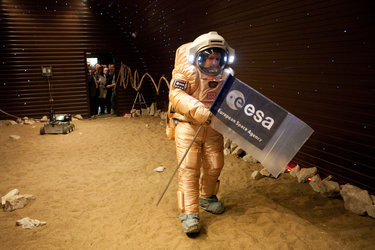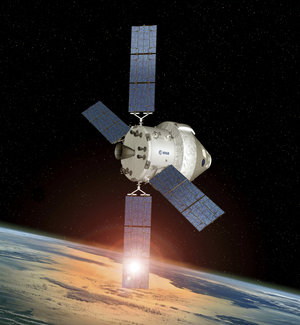Terrae Novae: Europe's exploration vision
ESA’s Terrae Novae exploration programme is leading Europe’s human journey into the Solar System using robots as precursors and scouts. Exploring space is about travelling farther and coming back with new experiences and knowledge to help us on Earth. Humankind will benefit from the new discoveries, ambitions, science, inspiration and challenges.
Guiding this programme, ESA’s Explore2040 is an ambitious exploration strategy for Europe to be at the forefront of sustained, sustainable and responsible human and robotic space exploration, providing unique contributions that return benefits to our society. The strategy’s goals include: continuing European presence in low Earth orbit, enabling Europeans to explore the Moon to better understand our Solar System and expanding our knowledge of Mars to prepare to take Europeans to this horizon goal and return them safely to Earth.
Terrae Novae

ESA’s human and robotic exploration programme is known by the name Terrae Novae, referring to the new worlds of our three exploration destinations: low Earth orbit, the Moon and Mars.
Terrae Novae symbolises the constant quest for innovation to find new and improved ways to deliver the exploration programme, reflecting the aspirations of ESA’s 22 Member States for Europe’s exploration to move to a self-determination and leadership mindset, to strengthen existing cooperation and foster new partnerships.

Four objectives steer Europe’s exploration strategy: science, economics, international cooperation and inspiration, with the goal of making space exploration an activity that benefits all.
Exploration is more than a space programme; it is an investment for future prosperity. Space exploration demonstrably generates high quality jobs and immediate economic return. Exploration science and technologies are an accelerator of sustainable development which are already generating solutions that make life on Earth more productive, cleaner and sustainable. Space exploration is also an inherently exciting, inspiring and motivating domain, capable of captivating and engaging the next generations.
The exploration campaigns to low Earth orbit, the Moon and Mars are in full swing and will position Europeans at the forefront of exploration. By delivering essential capabilities, ESA is now a key international partner in both Moon and Mars exploration.
Science, the ultimate destination

While curiosity is the engine of space exploration, knowledge is the ultimate destination. As science and its applications make space exploration a greater reality, the knowledge acquired reveals our history, informs our future and gives us a mirror – like the Pale Blue Dot – for an enhanced understanding of ourselves and our environment.
What are we doing this decade

- Flying more European astronauts on long-duration missions to the International Space Station, returning scientific benefits to society and inspiring the next generation of engineers, scientists and explorers
- Demonstrating our commitment to diversity and fair opportunities by preparing the first-ever mission to the International Space Station by an astronaut with a physical disability

- Preparing European industry to be a strong player in the future low Earth orbit economy by launching a cargo service competition and stimulating the development of commercial services
- Allowing astronauts to explore deep space for the first time since Apollo, thanks to ESA’s European Service Module, the powerhouse of the Orion vehicle.
- Providing key contributions to the lunar Gateway, the first international space station around the Moon that will support the most distant human space missions ever attempted.
- Assigning the first three ESA astronauts on missions to the Gateway supporting its assembly and operation, venturing farther from Earth than any European in history.
- Landing multiple scientific payloads on the surface of the Moon, prospecting for the presence of water and other volatile materials that will both reveal its history and help prepare sustainable exploration.
- Designing Europe’s large lunar lander, Argonaut, a multi-mission delivery truck for scientific payloads, rovers and infrastructure that will support sustained human exploration throughout the 2030s.

- Land and operate Rosalind Franklin, the first dedicated life-searching rover on Mars while continuing to probe the Red Planet’s atmosphere with our Trace Gas Orbiter.
- Advance the development of our contributions to Mars Sample Return, the most ambitious robotic exploration campaign ever attempted which is destined to return invaluable scientific material from another planet for the first time in history.
The next decades
ESA’s Explore2040 is an ambitious strategy that is affordable and achievable due to its clear long-term objectives that allow a stepwise approach, increasing European capabilities in space exploration through inspiring projects.
The coming decades will see a continued human presence in low Earth orbit, a sustained presence on the Moon and eventually, in the foreseeable future, expeditions to Mars. Explore2040 will steer the long-term vision for Europe’s decision makers about the human and robotic exploration of our Solar System so that the required decisions to ensure long-term European capabilities are made in a timely way.















 Germany
Germany
 Austria
Austria
 Belgium
Belgium
 Denmark
Denmark
 Spain
Spain
 Estonia
Estonia
 Finland
Finland
 France
France
 Greece
Greece
 Hungary
Hungary
 Ireland
Ireland
 Italy
Italy
 Luxembourg
Luxembourg
 Norway
Norway
 The Netherlands
The Netherlands
 Poland
Poland
 Portugal
Portugal
 Czechia
Czechia
 Romania
Romania
 United Kingdom
United Kingdom
 Slovenia
Slovenia
 Sweden
Sweden
 Switzerland
Switzerland













































